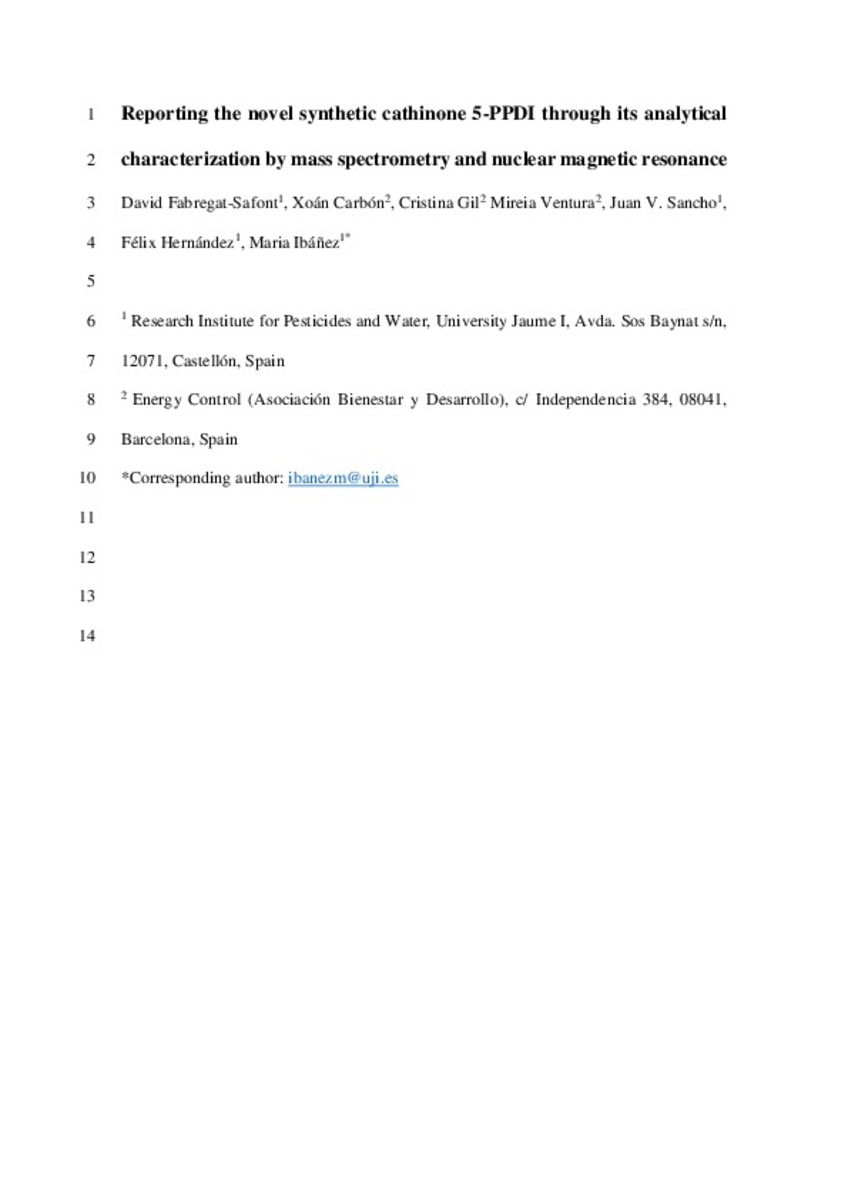Mostrar el registro sencillo del ítem
Reporting the novel synthetic cathinone 5-PPDI through its analytical characterization by mass spectrometry and nuclear magnetic resonance
| dc.contributor.author | Fabregat-Safont, David | |
| dc.contributor.author | Carbón, Xoán | |
| dc.contributor.author | Gil Iladanosa, Cristina | |
| dc.contributor.author | Ventura, Mireia | |
| dc.contributor.author | Sancho, Juan V | |
| dc.contributor.author | Hernandez, Felix | |
| dc.contributor.author | Ibáñez, Maria | |
| dc.date.accessioned | 2018-09-12T07:32:53Z | |
| dc.date.available | 2018-09-12T07:32:53Z | |
| dc.date.issued | 2018-07 | |
| dc.identifier.citation | FABREGAT-SAFONT, David; CARBÓN, Xoán; GIL ILADANOSA, Cristina; VENTURA, Mireia; SANCHO LLOPIS, Juan Vicente; HERNÁNDEZ HERNÁNDEZ, Félix; IBÁÑEZ MARTÍNEZ, María (2018). Reporting the novel synthetic cathinone 5-PPDI through its analytical characterization by mass spectrometry and nuclear magnetic resonance. Forensic Toxicology, v. 36, issue 2, p. 447-457 | ca_CA |
| dc.identifier.uri | http://hdl.handle.net/10234/176034 | |
| dc.description.abstract | Introduction: User surveys indicate that expectations of higher drug purity are a key reason for cryptomarket use. In 2014–2015, Spain’s NGO Energy Control conducted a 1-year pilot project to provide a testing service to cryptomarket drug users using the Transnational European Drug Information (TEDI) guidelines. In this paper, we present content and purity data from the trial. Methods: 219 samples were analyzed by gas chromatography associated with mass spectrometry (GC/ MS). Users were asked to report what substance they allegedly purchased. Results: 40 different advertised substances were reported, although 77.6% were common recreational drugs (cocaine, MDMA, amphetamines, LSD, ketamine, cannabis). In 200 samples (91.3%), the main result of analysis matched the advertised substance. Where the advertised compound was detected, purity levels (m SD) were: cocaine 71.6 19.4%; MDMA (crystal) 88.3 1.4%; MDMA (pills) 133.3 38.4 mg; Amphetamine (speed) 51.3 33.9%; LSD 123.6 40.5 m g; Cannabis resin THC: 16.5 7.5% CBD: 3.4 1.5%; Ketamine 71.3 38.4%. 39.8% of cocaine samples contained the adulterant levamisole (11.6 8%). No adulterants were found in MDMA and LSD samples. Discussion: The largest collection of test results from drug samples delivered from cryptomarkets are reported in this study. Most substances contained the advertised ingredient and most samples were of high purity. The representativeness of these results is unknown | ca_CA |
| dc.format.extent | 4 p. | ca_CA |
| dc.format.mimetype | application/pdf | ca_CA |
| dc.language.iso | eng | ca_CA |
| dc.publisher | Springer | ca_CA |
| dc.relation.isPartOf | Forensic Toxicology (2018), v. 36, issue 2 | ca_CA |
| dc.rights.uri | http://rightsstatements.org/vocab/CNE/1.0/ | * |
| dc.subject | Cryptomarkets | ca_CA |
| dc.subject | Drug markets | ca_CA |
| dc.subject | Purity | ca_CA |
| dc.subject | Adulterants | ca_CA |
| dc.subject | Drug checking | ca_CA |
| dc.subject | Drug trend monitoring | ca_CA |
| dc.title | Reporting the novel synthetic cathinone 5-PPDI through its analytical characterization by mass spectrometry and nuclear magnetic resonance | ca_CA |
| dc.type | info:eu-repo/semantics/article | ca_CA |
| dc.identifier.doi | https://doi.org/10.1007/s11419-018-0422-0 | |
| dc.relation.projectID | National Health & Medical Research Council Early Career Researcher Fellowship (APP1070140). | ca_CA |
| dc.rights.accessRights | info:eu-repo/semantics/restrictedAccess | ca_CA |
| dc.relation.publisherVersion | https://link.springer.com/article/10.1007/s11419-018-0422-0 | ca_CA |
| dc.contributor.funder | The National Drug Research Institute in the Faculty of Health Sciences at Curtin University and the National Drug and Alcohol Research Centre at UNSW Australia are supported by funding from the Australian Government under the Substance Misuse Prevention and Service Improvement Grants Fund | ca_CA |
| dc.type.version | info:eu-repo/semantics/publishedVersion | ca_CA |
Ficheros en el ítem
Este ítem aparece en la(s) siguiente(s) colección(ones)
-
IUPA_Articles [307]







